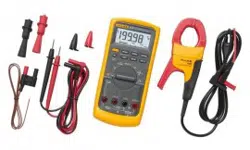Loading ...
Loading ...
Loading ...

Multimeters
Making Measurements
27
Measuring Frequency
The Meter measures the frequency of a voltage or current
signal by counting the number of times the signal crosses
a threshold level each second.
Table 6 summarizes the trigger levels and applications for
measuring frequency using the various ranges of the
Meter's voltage and current functions.
To measure frequency, connect the Meter to the signal
source; then press
G. Pressing E switches the
trigger slope between + and -, as indicated by the symbol
at the left side of the display (refer to Figure 9 under
"Measuring Duty Cycle"). Pressing
D stops and starts
the counter.
The Meter autoranges to one of five frequency ranges:
199.99 Hz, 1999.9 Hz, 19.999 kHz, 199.99 kHz, and
greater than 200 kHz. For frequencies below 10 Hz, the
display is updated at the frequency of the input. Below 0.5
Hz, the display may be unstable.
The following are some tips for measuring frequency:
• If a reading shows as 0 Hz or is unstable, the input
signal may be below or near the trigger level. You can
usually correct these problems by selecting a lower
range, which increases the sensitivity of the Meter. In
the L function, the lower ranges also have lower
trigger levels.
• If a reading seems to be a multiple of what you
expect, the input signal may be distorted. Distortion
can cause multiple triggerings of the frequency
counter. Selecting a higher voltage range might solve
this problem by decreasing the sensitivity of the
Meter. You can also try selecting a dc range, which
raises the trigger level. In general, the lowest
frequency displayed is the correct one.
1.888.610.7664 sales@GlobalTestSupply.com
Fluke-Direct.com
Loading ...
Loading ...
Loading ...
